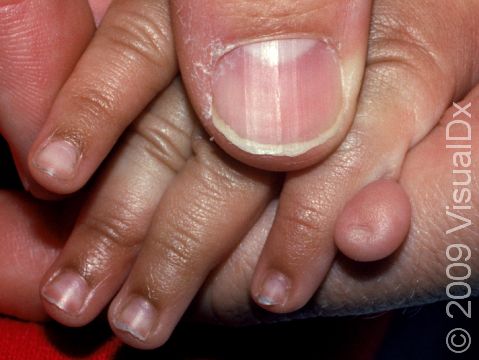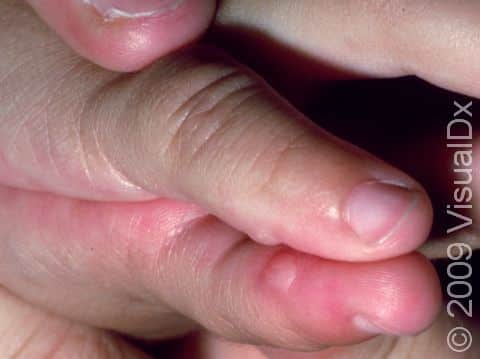Polydactyly (Supernumerary Digit)
Polydactyly, sometimes called supernumerary digits or extra digits, refers to the occurrence of extra fingers, toes, or parts of these digits. Polydactyly can be classified by extra digits that occur on the side of the thumb or big toe, extra digits that occur on the side of the little finger or the last toe (most common), and those that involve the fingers or toes in the middle. Polydactyly can occur on just the hands, just the feet, or on both the hands and the feet.
Polydactyly may be diagnosed during prenatal ultrasound, or sometimes it is diagnosed at birth.
Who's At Risk?
Polydactyly occurs in about 1 in 500-1000 babies. It may occur in babies who have a family history, meaning it can be inherited. White and Asian babies are more likely to have an extra thumb, whereas having an extra little finger is more common in Black babies.
Signs & Symptoms
An extra digit most commonly occurs on the little finger. The extra digit may be fully developed and look like the rest of the digits on the hands or feet, containing bone, but more often the extra digit or digits are less developed and may only be attached by flesh and skin. Polydactyly can be an isolated finding at birth, meaning there is no associated underlying genetic disorder and the cause is unknown, or it may be seen with other conditions or disorders. When it occurs with other features, it may be related to a genetic condition involving an extra part of or whole chromosome.
Self-Care Guidelines
There are no self-care guidelines if your baby has polydactyly. Extra digits should not be “tied off” or removed at home.
Treatments
Your medical professional may refer you to a surgeon if surgical removal is desired. The goals of surgery are to improve the cosmetic appearance of the hand or foot and to prevent progressive deformity as the child grows. The surgery for fully formed extra digits (bone, flesh, and skin) is often deferred until approximately 9-12 months so the baby can better tolerate the anesthesia involved in the surgery. However, small digits not containing bone may be surgically removed earlier. Those who seek removal typically recover without issue and with little need for physical therapy.
Visit Urgency
See a medical professional if your baby is born with any extra digits. An x-ray may be needed to determine whether there is bone in the extra digit or digits. The medical professional may recommend genetic counseling if there is a family history of a genetic disorder. Once the baby’s polydactyly is classified, the medical professional can discuss potential next steps. If your baby has polydactyly and there is skin color change in the area or there is decreased functioning in the in hand or foot, contact your baby’s medical professional. Also see a medical professional if you notice the extra digits cause discomfort for the baby, such as when the child starts wearing shoes.
References
Boston Children’s. Polydactyly. Boston Children’s Hospital. https://www.childrenshospital.org/conditions/polydactyly. Accessed 2023 Nov 15.
Cunningham F, Leveno KJ, Dashe JS, et al. Normal and abnormal fetal anatomy. In: Cunningham FG, Leveno KJ, Dashe JS, Hoffman BL, Spong CY, Casey BM, eds. Williams Obstetrics. 26th ed. McGraw Hill; 2022. Nationwide Children’s Hospital. Polydactyly.
Nationwide Children’s. Polydactyly. Nationwide Children’s Hospital. https://www.nationwidechildrens.org/conditions/polydactyly. Accessed 2023 Nov 15.
Last modified on January 26th, 2024 at 1:10 pm

Not sure what to look for?
Try our new Rash and Skin Condition Finder

